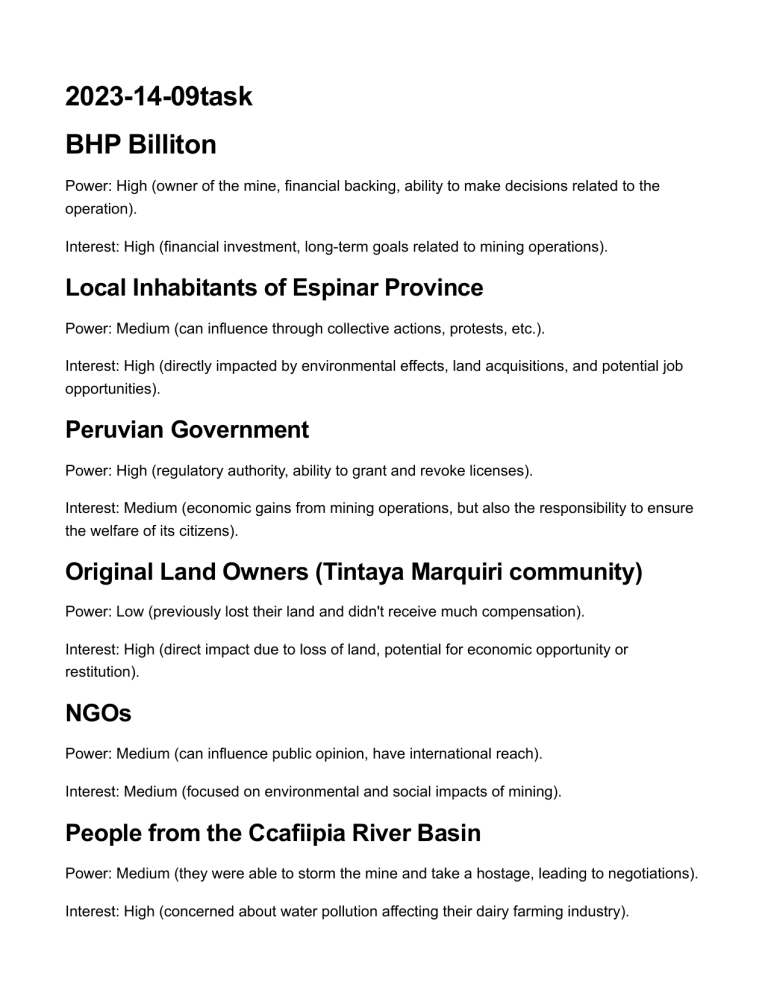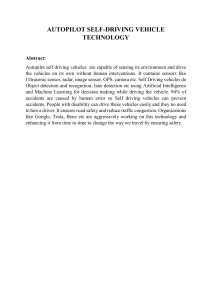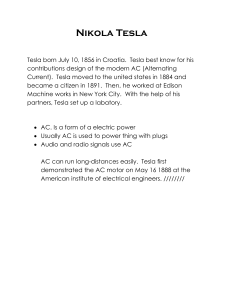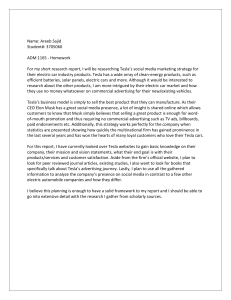
2023-14-09task BHP Billiton Power: High (owner of the mine, financial backing, ability to make decisions related to the operation). Interest: High (financial investment, long-term goals related to mining operations). Local Inhabitants of Espinar Province Power: Medium (can influence through collective actions, protests, etc.). Interest: High (directly impacted by environmental effects, land acquisitions, and potential job opportunities). Peruvian Government Power: High (regulatory authority, ability to grant and revoke licenses). Interest: Medium (economic gains from mining operations, but also the responsibility to ensure the welfare of its citizens). Original Land Owners (Tintaya Marquiri community) Power: Low (previously lost their land and didn't receive much compensation). Interest: High (direct impact due to loss of land, potential for economic opportunity or restitution). NGOs Power: Medium (can influence public opinion, have international reach). Interest: Medium (focused on environmental and social impacts of mining). People from the Ccafiipia River Basin Power: Medium (they were able to storm the mine and take a hostage, leading to negotiations). Interest: High (concerned about water pollution affecting their dairy farming industry). Left-wing Political Parties and Student Groups Power: Medium (able to mobilize protests and draw attention to the issue). Interest: Medium (political motivations and concern for the broader community). General Public (outside of Espinar Province) Power: Low (not directly involved in the operation, but can influence public opinion). Interest: Low (not directly impacted by the mining operation, but may have concerns about environmental and social issues). Analysis Summary: The most powerful and interested stakeholders are BHP Billiton, the Peruvian Government, and the local inhabitants of the Espinar Province. BHP Billiton and the government have the most direct power and influence over the mine's operations, but the local inhabitants and other groups have shown that they can wield significant power through protests and collective actions. The interest of the local inhabitants is especially high given the direct impacts on their lives. 1. PEST Analysis for Tesla Motors: Political: Government regulations and standards impacting the electric vehicle (EV) sector. State-level decisions on phasing out tax credits for alternative-fuel vehicles. Political incentives for renewable energy sources and sustainability. Economic: Steep decline in crude oil prices impacting the demand for EVs. Lower gas prices encourage Americans to buy larger, gas-guzzling vehicles. Global economic conditions which affect consumer spending and financing options. Sociocultural: Growing awareness and concern about environmental issues. Consumer perceptions of electric cars versus traditional gasoline vehicles. The prestige or appeal associated with owning an innovative, tech-driven vehicle like Tesla. Technological: Rapid advancements in battery technology. Development of self-driving car technology by companies like Google. Traditional automakers integrating EV or hybrid technology into their lineup. 2. Porter’s Five Forces Analysis for Tesla Motors: Threat of New Entrants: High due to the success of Tesla in circumventing barriers with innovative technology. Tech giants like Google and Apple entering or showing interest in the EV market. Bargaining Power of Suppliers: High, especially for lithium-ion battery packs. Limited suppliers, with companies like Panasonic being a key player. Bargaining Power of Buyers: Moderate. Tesla targets a niche market of environmentally-conscious and tech-savvy consumers. However, as the EV market grows, this power may increase. Threat of Substitute Products: High, with traditional gasoline vehicles, especially with the decrease in gas prices. Hybrid cars also present an alternative to fully electric vehicles. Rivalry Among Existing Competitors: High with traditional car manufacturers like GM, Ford, and Nissan introducing or already having electric vehicles. New entrants like Google and Apple can intensify this rivalry. 3. Top Three Strategic Recommendations for Elon Musk: 1. Diversify Battery Technology: Tesla should invest in R&D for alternative battery technologies. While lithium-ion is the current standard, the potential emergence of a superior technology could disrupt Tesla's investments. 2. Broaden Market Reach: Given the U.S. market's current inclination towards gas vehicles due to low oil prices, Tesla should look to expand more aggressively in markets where gasoline prices remain high or where environmental concerns are paramount. 3. Collaborations and Partnerships: Consider strategic partnerships with tech firms entering the EV space (like Google or Apple). This would leverage their technological expertise and brand strength, possibly leading to advancements in self-driving technology or in-car systems. 4. Electric Vehicles in Azerbaijan: External Opportunities: Growing global focus on sustainability may push Azerbaijan to adopt greener initiatives. Azerbaijan has abundant solar energy which could be tapped into for EV charging infrastructures. Partnership potential with countries and companies leading in EV tech for mutual benefits. External Threats: Azerbaijan is an oil-rich nation; thus, the country's economy and interests are deeply tied to oil. Lack of existing infrastructure for electric vehicles. Potential resistance from the oil industry and associated stakeholders. For a comprehensive electric vehicle production business in Azerbaijan, proper governmental support, investments in infrastructure, and awareness campaigns would be crucial. 1. Stakeholders' Analysis for BP: Protagonists (Involved Parties): BP (and its management/employees) U.S. government (and agencies like EPA) Small business owners in the tourism and seafood industries Workers on the Deepwater Horizon oil rig (and their families) General public and environmental activists Stakeholders: 1. BP shareholders and investors 2. Employees of BP 3. Victims of the oil spill and their families 4. Small business owners in affected areas 5. U.S. government and regulatory bodies 6. Environmentalists and environmental NGOs 7. The general public 8. Other oil and gas companies Stakeholders' Analysis Table: Stakeholder Interest/Concern Power/Influence Potential Impact on BP BP Shareholders & Investors Profitability and company reputation High Influence company decisions and directions, capital inflow BP Employees Job security, company reputation Medium Productivity, company morale Victims and families Justice, compensation Medium-High Legal battles, compensation payouts Small Business Owners Compensation for losses Medium Claims against the company, media coverage U.S. Government & Regulatory Bodies Upholding the law, public safety High Legal actions, penalties, revoking licenses Environmentalists & NGOs Environment protection Medium Media campaigns, public opinion influence General Public Environmental safety, company accountability Medium Reputation, sales, brand trust Other oil and gas companies Industry reputation, regulatory changes Medium Industry-wide standards, competition 2. Actions BP’s management could have done differently: 1. Strengthened Safety Protocols: Despite past incidents, BP failed to instate a rigorous safety culture. They should have done periodic safety reviews and updated procedures. 2. Avoided Cost Cutting at the Expense of Safety: Cost-reduction shouldn't compromise essential factors like safety. Balanced financial decision-making could have prevented negligence. 3. Proactive Response: Once the incident occurred, BP could have been faster and more efficient in responding to the disaster, reducing the environmental and reputational impact. 4. Transparent Communication: BP’s management could have communicated more transparently and regularly with the public and stakeholders about the crisis and their response. 5. Immediate Responsibility: Acknowledging mistakes and taking responsibility quickly can build trust, rather than denying or deflecting blame. 3. CSR Activities Recommendations for BP: 1. Environmental Restoration: Dedicate funds and manpower to restore affected habitats and marine life in the Gulf of Mexico. 2. Safety Training & Education: Invest in comprehensive safety training for employees and initiate programs to educate the community about safe oil practices. 3. Community Engagement: Engage with affected communities, providing resources and aid to help them recover. This could include scholarships, local projects, or business grants. 4. Renewable Energy Initiatives: Diversify into renewable energy sources, showcasing a commitment to sustainable and safe energy. 5. Transparency Initiatives: Regularly publish updates about safety measures, environmental initiatives, and company policies to build trust with the public. 6. Partnerships with Environmental NGOs: Collaborate with environmental organizations for cleanup and conservation projects. 7. Commitment to Research: Fund research into safer drilling technologies and practices. 8. Community Feedback: Set up feedback channels for communities to voice concerns or provide suggestions on company operations and CSR activities.







